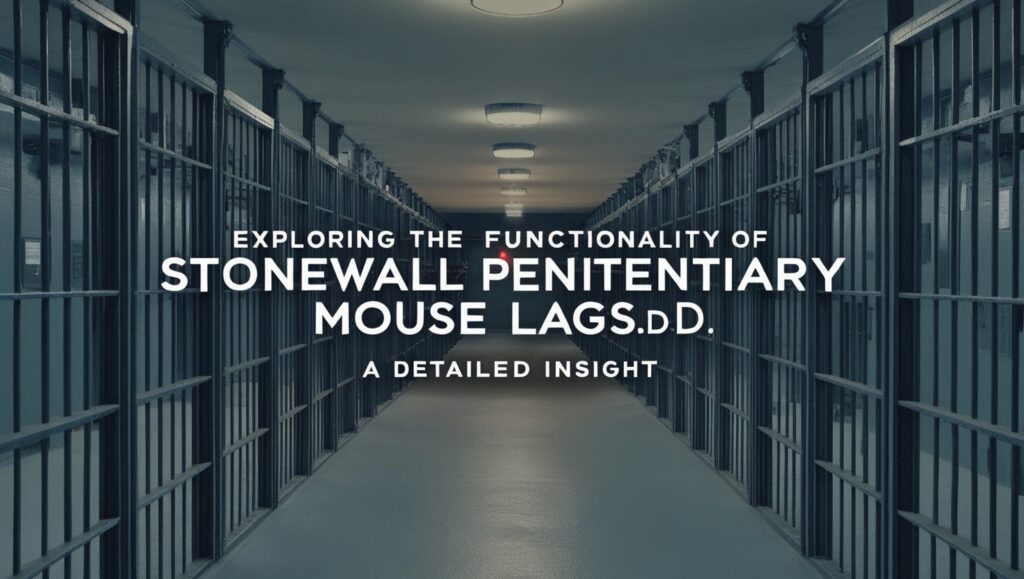Introduction
In today’s fast-evolving digital and security landscape, certain terms may sound obscure but are important in specific fields. One such term is “stonewall penitentiary mouse Lagsd.” While it may seem like an unusual combination of words, understanding its potential applications and significance reveals an intersection between penitentiary security, technology, and management. This article explores the possible meanings, technological importance, and relevance of the term “stonewall penitentiary mouse Lagsd,” unraveling its application in physical and digital contexts.
Understanding the Concept of Stonewall Penitentiary
Penitentiaries have a long history, traditionally associated with strict and often unforgiving institutions designed to hold individuals who have committed serious offenses. The term “stonewall penitentiary” evokes images of fortified structures, but in the modern sense, it also reflects a system of symbolic barriers. Integrating “stonewall penitentiary” with “mouse Lagsd” suggests a deeper, technologically influenced meaning.
The Evolution of Penitentiary Systems
Penitentiary systems worldwide have evolved from simple correctional institutions to highly secure, tech-driven environments. The security of such places no longer depends on physical walls alone. Technological tools, security protocols, and digital surveillance have become central to the functioning of modern prisons. The “Stonewall Penitentiary Mouse Lagsd” might refer to systems or protocols that help safeguard these institutions.
Stonewalling in Security Systems
In security terminology, “stonewalling” is often used to describe methods of blocking or obstructing access. This may also apply in a penitentiary system where stonewalling prevents unauthorized access to sensitive areas or digital systems. “Stonewall Penitentiary Mouse Lagsd” could thus reference security measures designed to ‘stonewall’ cyber threats or control unauthorized behavior within the prison.

Decoding “Mouse” in Stonewall Penitentiary Mouse Lagsd
The term “mouse” typically refers to a device used to navigate digital systems, especially in a computing environment. In the context of “Stonewall Penitentiary Mouse Lagsd,” it may symbolize the role of navigation tools within the penitentiary security system.
The Role of Digital Interfaces in Penitentiaries
In today’s penitentiary environment, security personnel often rely on digital tools to monitor and manage the prison system. A “mouse” in this context could represent the control mechanism or the point of interaction with security software. It is possible that “Stonewall Penitentiary Mouse Lagsd” refers to a specific digital navigation tool used within these systems to enhance monitoring and control over inmates and their activities.
Mouse-Based Security in Prison Systems
The use of a mouse in prison-related technologies might extend beyond traditional usage. “Mouse land” could represent software navigation tools that help with surveillance, tracking, and data management in a prison. Penitentiaries increasingly require real-time monitoring systems, and the mouse-based interface might be essential in this respect.
What Does Lagsd Mean in Stonewall Penitentiary Mouse Lagsd?
“Lagsd” is not widely recognized in most contexts, leaving room for interpretation. It could be an acronym or a specialized technical term. Within “Stonewall Penitentiary Mouse Lagsd,” it likely refers to some form of lag, delay, or digital functionality related to prison technology.
Exploring Potential Meanings of Lagsd
One possibility is that “lagsd” refers to lag in digital communication or functionality. In complex penitentiary systems, lag could represent delays in information processing, which could be detrimental to prison security. The term “Stonewall Penitentiary Mouse Lagsd” may refer to technology designed to address or prevent these lags, ensuring penitentiary systems’ smooth and uninterrupted functioning.
Lagsd as a Monitoring System
Alternatively, “land” might be an acronym for a specific security system or tool used in prisons. It could relate to a software component that tracks inmate behavior, movement, or other aspects of prison life. This makes the “Stonewall Penitentiary Mouse Lagsd” term especially significant, as it could represent a sophisticated system for real-time surveillance and response in penitentiaries.

The Importance of Technology in Modern Penitentiaries
Technology is at the heart of modern penitentiary management. The shift from physical control to digital oversight has allowed better prison safety, accountability, and efficiency. The term “Stonewall Penitentiary Mouse Lagsd” might embody this shift towards more advanced technological integration in the penitentiary system.
Security Measures in Digital Systems
Digital security systems are critical for maintaining control in prisons. The digital interface plays a central role, from surveillance cameras to biometric systems and inmate tracking technologies. “Stonewall Penitentiary Mouse Lagsd” may refer to a set of tools or security protocols that assist in controlling these digital elements securely and efficiently.
Addressing Lag in Penitentiary Systems
Lag—delays in communication or processing—can be a critical issue in any tech-based system. In prisons, where real-time monitoring is essential, lag could lead to security breaches or system failures. “Stonewall Penitentiary Mouse Lagsd” could highlight the importance of resolving such delays, ensuring that prison systems operate without interruption.
The Role of Stonewall Penitentiary Mouse Lagsd in Ensuring Inmate Security
Ensuring inmate security is a complex task involving monitoring behavior, controlling access, and preventing any breach. The term “Stonewall Penitentiary Mouse Lagsd” might represent the technologies and protocols that effectively manage these elements.
Tracking Inmate Behavior
Modern penitentiary systems rely heavily on tracking technology. Monitoring inmate behavior is critical, whether through wearable devices, cameras, or digital interfaces. The “Stonewall Penitentiary Mouse Lagsd” could represent a specific interface or tool to assist security staff in tracking movements and activities in real time.

Preventing Security Breaches
Penitentiary security breaches can be catastrophic, leading to potential harm or escape. To prevent this, penitentiaries employ sophisticated security measures. “Stonewall Penitentiary Mouse Lagsd” may refer to security tools that prevent unauthorized access to critical areas, ensuring that breaches are detected and addressed immediately.
Conclusion
While “Stonewall Penitentiary Mouse Lagsd” might seem obscure, it likely represents an intersection of security, technology, and penitentiary management. The combination of these elements suggests using advanced digital tools and protocols designed to maintain security, prevent lag in communication or processing, and ensure the smooth functioning of prison systems. By exploring its components, it becomes clear that “Stonewall Penitentiary Mouse Lagsd” reflect the growing role of technology in modern prisons.



